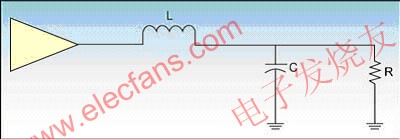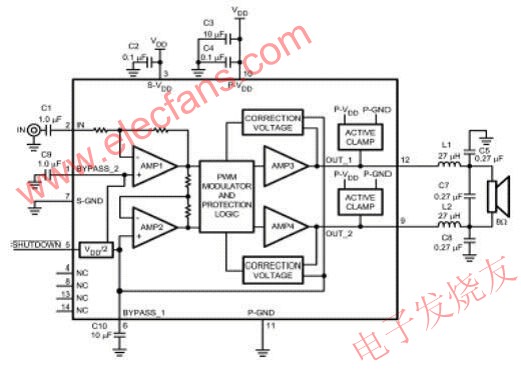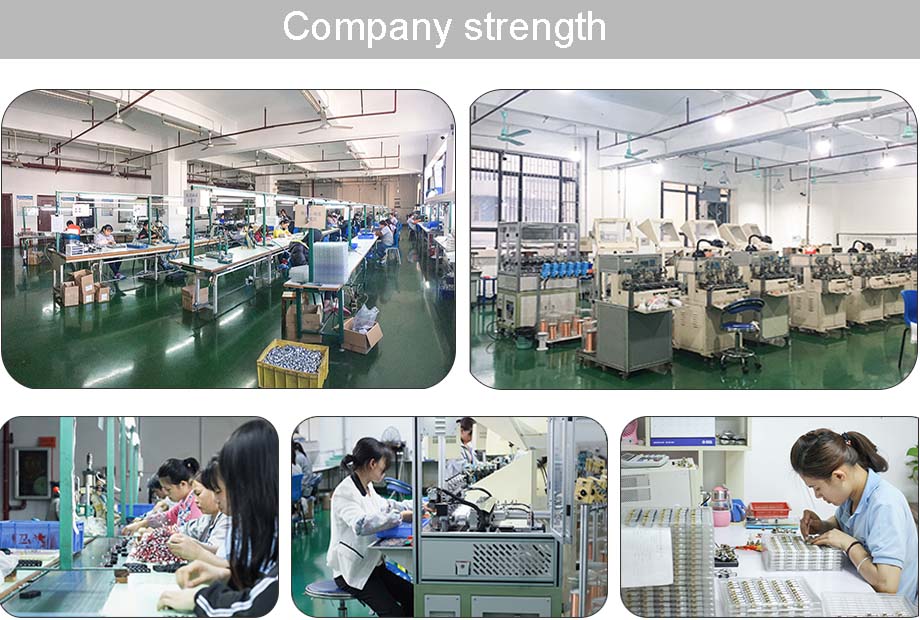In portable and miniaturized consumer products, the application of Class D audio power amplifiers is very common. This article introduces the design principle of the output low-pass filter of the class D audio amplifier, and gives the calculation method of the inductance and capacitance value in the filter and the considerations when selecting. This article also takes National Semiconductor's Class D audio amplifiers LM4668 and LM4680 as examples, describes the specific output filter design method, and introduces the circuit block diagram and characteristics of the upcoming LM4681.
All along, audio signals in electronic systems are represented by analog electrical signals. Although digital processing and digital amplification techniques have been used in today's systems, audio / sound signals must still be converted back to analog signals to meet the needs of people's hearing systems to listen to music.

Figure 1: The composition of a monolithic Class D audio amplifier.
At present, in most portable and miniaturized consumer products, such as MP3, portable DVD and flat panel displays, the application of switch mode (Class D) audio power amplifiers is very common. Due to the low power consumption of Class D amplifiers, higher efficiency can be achieved. It extends the battery life of portable devices, and can reduce the size of the heat sink and PCB area, thereby saving system costs. Therefore, many large flat panel displays and consumer audio products are more willing to use such amplifiers.
However, Class D amplifiers are based on digital modulation techniques that use high-switching-frequency signals and are designed to efficiently amplify signals. The modulation frequency is usually as high as several hundred kHz, which is far beyond the audio frequency range. Welcome to reprint, this article comes from the electronic enthusiast network (http: //)
Since we need to recover the required real audio signal (music) from the digitized or modulated signal, an output low-pass filter must be used to filter out high-frequency components to reproduce the real analog signal that matches the human hearing system.
Here, we will elaborate some considerations and suggestions regarding the design of the output low-pass filter.

Figure 2: BTL half circuit model.
Class D amplifiers: Monolithic Class D audio amplifiers include analog audio inputs, modulators, power transistors, etc. (see Figure 1).
Output filter design: Since we need to recover the required audio signal, it is important to design an excellent output low-pass filter to filter out high-frequency components (useless signals) and obtain high-quality analog sound. We must design an output filter with a specific reactive output impedance to match the load impedance. The BTL half-edge circuit model is shown in Figure 2.
The output filter of a Class D amplifier is usually a second-order, LC-type Butterworth filter. This is because Butterworth filters can provide a relatively flat passband frequency response, and the number of components required is small. Here is a reference graph for displaying the LPF response of Butterworth, Bessel and Chebyshev filters (Figure 3).

Figure 3: Comparison of low-pass filter responses for Butterworth, Bessel, and Chebyshev filters. \
For an actual BTL circuit, the output filter is shown in Figure 4.
The derived BTL filter equation is:
Based on the above equation, Table 1 lists the inductance (L) and capacitance (C) values ​​corresponding to specific fc and RL.
Inductor selection: In the output filter, inductance is the key component. It is related to the DC resistance and rated peak current specifications of the Class D audio power amplifier system. The DC resistance reflects the efficiency of the total output power. The efficiency of the system can be estimated by the following formula:
Where: RL is the DC resistance of the speaker, RDSON is the on-resistance of the transistor of the output driver in the Class D amplifier; RIND is the DC resistance of the inductor.
Figure 4: Actual BTL circuit output filter.
In addition to selecting the appropriate inductance value to obtain a specific cutoff frequency, the maximum DC resistance of the output inductor is another key parameter that affects overall efficiency. Therefore, it is strongly recommended to use an inductor with a low DC resistance.
For inductance, another important parameter that must be considered is its maximum rated current. If the rated current of the inductor is insufficient to maintain the output current of the device, the inductor will act as a short circuit. This will cause the device or speaker to be damaged by high current.

Figure 5: Application block diagram of LM4680 (the value of the LC output filter is determined).
Finally, it is worth mentioning that in order to reduce distortion, EMI and crosstalk, it is recommended to use shielded inductors (for example: pot-shaped core inductors).
The pot-shaped iron core is known for its excellent shielding performance, because the inductor coil is completely surrounded by the magnetic core except for the two narrow slots for passing through the wire. Welcome to reprint, this article comes from the electronic enthusiast network (http: //)
Capacitor selection: In the process of evaluating high-frequency chip capacitors, one of the most important parameters is Q (quality factor), or related equivalent series resistance (ESR).
Simply put, ESR is a measure of all series and parallel losses in a capacitor at a given frequency. Theoretically, the ESR of an "ideal" capacitor will be 0Ω, and it is purely reactive, with no real (resistive) component. The current flowing through the capacitor will just lead the voltage across the capacitor by 90 at all frequencies
Hotel Door Lock Motor also known as Smart Hotel Door Lock Motor, perform operations in the hotel door lock, at this point, the cardholder simply throw the door handle to open the door. That is to say the hotel Door Lock Motor is used to open the door.
Induction door lock is a infrared sensor through induction of new security equipment, widely used in hotels, hotels and clubs, and other areas of the smart IC card, rf door lock, generally divided into induction induction door lock system, provides the high quality for the hotel induction door lock system. Induction in the European and American countries have been developed to a certain extent, has been a measure of the quality of life index of height and life.
Operating temperature range:
Hotel door Lock Motor should be used at a temperature of -10~60℃.
The figures stated in the catalog specifications are based on use at ordinary room temperature catalog specifications re based on use at ordinary room temperature (approximately20~25℃.
If a Smart Hotel Door Lock Motor is used outside the prescribed temperature range,the grease on the gearhead area will become unable to function normally and the motor will become unable to start.Depending on the temperature conditions ,it may be possible to deal with them by changing the grease of the motor's parts.Please feel free to consult with us about this.
Storage temperature range:
lock motor should be stored ta a temperature of -15~65℃.
In case of storage outside this range,the grease on the gearhead area will become unable to function normally and the motor will become unable to start.
Service life:
The longevity of Smart Hotel Door Lock Motor is greatly affected by the load conditions , the mode of operation,the environment of use ,etc.Therefore,it is necessary to check the conditions under which the product will actually be used .The following conditions will have a negative effect on longevity.Please consult with us should any of them apply.
â—Use with a load that exceeds the rated torque
â—Frequent starting
â—Momentary reversals of turning direction
â—Impact loads
â—Long-term continuous operation
â—Forced turning using the output shaft
â—Use in which the permitted overhang load or the permitted thrust load is exceeded
â—A pulse drive ,e.g.,a short break,counter electromotive force,PWM control
â—Use of a voltage that is nonstandard as regards the rated voltage
â—Use outside the prescribed temperature or relative-humidity range,or in a special environment.
â—Please consult with us about these or any other conditions of use that may apply,so that we can be sure that you select the most appropriate model.
Hotel door lock motor applicable door types: building doors, fire doors, security doors, door and office door, fire doors, etc. Applicable scenario: family, company, office buildings, schools, shopping malls, such as Banks.
when it come to volume production,we're a major player as well .each month,we rurn out 600000 units,all of which are compliant with the rohs directive.Have any questions or special needed, please contact us, we have the engineer group and best sales department to service to you
Looking forward to your inquiry. Welcome to our factory.

Hotel Door Lock Motor
Hotel Door Lock Motor,Smart Hotel Door Lock Motor,Hotel Keyless Door Lock Motor,Fingerprint Hotel Door Lock Motor
Shenzhen Shunchang Motor Co., LTD. , https://www.scgearmotor.com